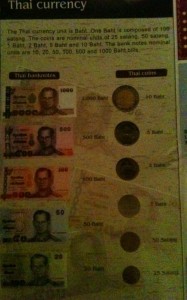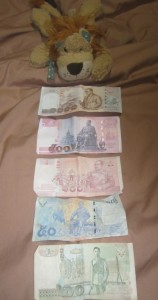When Lewis the Lion first arrived in Thailand, he was very grateful for this information that he picked up at the airport which was on the map of Bangkok. Here he learnt a little bit more about the Thai currency, the Thai Baht (THB) and its units satangs.
When he first withdrew some cash from the cash point at the airport the first thing that he noticed was that the King of Thailand’s image appeared on all of the notes. He then realised that Thailand must have a monarchy and he thought it was perhaps in the same way that Queen Elizabeth II’s head appeared on various notes and coins back in the UK.
He then also realised that the main faith in Thailand must be Buddhist because on the reverse of the notes he discovered that they showed various Buddhist temples from around Bangkok, Thailand’s capital city.
On his travels, one of his friend’s Joshua had given Lewis the Lion a top-tip on converting pounds to the Thai Baht. He said that for every pound, it was approximately 50 Bahts.
Can you see if you can therefore complete this conversion chart for Lewis the Lion? (Approximate values)
50p =
£1 = 50 THB
£2 =
£5 =
£10 =
£15 =
£20 =
Do you find it easy to convert numbers to Thai Bahts from Pound Sterling? Why or why not?
Explain your strategy to a friend to help them understand how you have worked it out.



